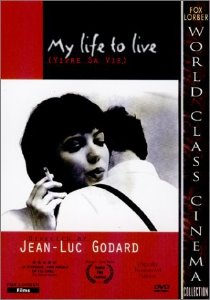My Life to Live
 The chief signifier, as well as the key to subjectivity itself in film, lies in the human face. Jean-Luc Godard, being the wilely connoisseur of everything cinema related, has long understood this fact, and so when the opening act of his film My Life to Live (1962) repudiates any shot of identification vis-a-vis close-ups of the human face, and instead focuses on the back of the human head, it becomes clear that Godard is self-consciously distancing the viewer while also expressing the lack of individual will and agency within the heroine of the film.
The chief signifier, as well as the key to subjectivity itself in film, lies in the human face. Jean-Luc Godard, being the wilely connoisseur of everything cinema related, has long understood this fact, and so when the opening act of his film My Life to Live (1962) repudiates any shot of identification vis-a-vis close-ups of the human face, and instead focuses on the back of the human head, it becomes clear that Godard is self-consciously distancing the viewer while also expressing the lack of individual will and agency within the heroine of the film.So much of this film is about inexpressed or inadequately articulated desire. Comprised of 12 self-contained tableauxs, or vignettes, our heroine, Nana Kleinfrankenheim (Anna Karina), observes early on in the film that "The more one talks, the less the words mean," and this observation epitomizes the entirety of Nana's existence, so that whenever she strives to understand an idea or an action, she more often merely confuses the issue. Hidden inside the tale of Nana's descent into prostitution lies a film deeply concerned with the matter of language and reason, and Godard fashions Nana as his accomplice in questioning the nature of language.
The camera often denies Nana angles wherein her facial features are highlighted, and, again, this self-reflexive act allows Godard to critique his heroine's lack of agency for herself. Instead, she is continually dependent on and displayed as the object of others, so that any positive self-worth she might possess is neutralized and made irrelevant. Though her status of prostitute later in the film enforces this position, Godard makes it clear that it is Nana as an individual who lacks self-expression and desire.
Yet because this is still Godard, there are passages of extreme beauty and vitality, such as the dance sequence around a pool table wherein Nana harnesses an innocence and simplicity that become infectious. Additionally, the philosophical debate between Nana and the old man in the restaurant, as well as the reading of Edgar Allan Poe, allow the film a depth and self-reflexive commentary on the nature of cinema as art. When Poe's narrator is confronted with the desire to either save the art or destroy the art in order to save the human being who influenced it, the narrator destroys the art. In this same manner, Godard, who was married to actress Anna Karina for some years, also examines this same scenario, in that she will either live on in the art (cinema) or in life (reality), but not in both. The ending answers which choice Godard made.
Beyond these scenes, there is the marvelous tableaux where Nana goes to the cinema to view Dreyer's The Passion of Joan of Arc (1928), which should be a sign to those viewing the film on its commentary on martyrs and martyrdom. In the end, this film is, simply put, a wonderful film, full of the customary asides and self-reflexiveness that Godard is famous for, but My Life to Live is also deeply human. See it.
My Live to Live: 10/10

0 Comments:
Post a Comment
<< Home